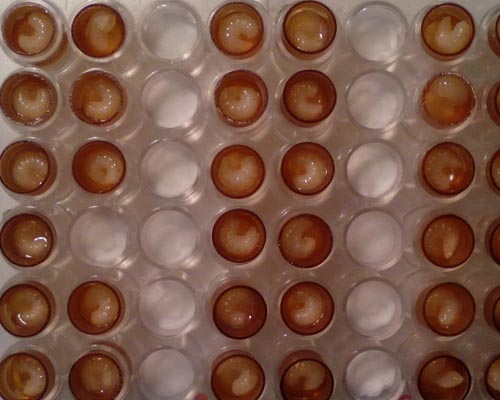OECD Guidance Document No 239 on Honey bee Larval Toxicity Test following Repeated Exposure
Agriculture provides habitat and forage for pollinating insects such as honey bees.
As well as producing honey and a variety of hive products, honey bees perform the ecosystem service of pollination which allows plants to reproduce, provides the fruits and seeds.The use of plant protection product in agriculture leads to exposure of honey bees to pesticide residues.
Honeybee larvae are collected from at least 3 healthy colonies with known history and physiological status. Queens are confined in their colonies in exclusion cages with empty combs, after 1 day the queens are released and the laid eggs are left in the cages inside the hives until hatching. The combs, containing first instars larvae, are transferred from hives to laboratory. On day 1, larvae are grafted on crystal polystyrene grafting cells, containing the diet. From day 3 to day 6 the test item is administered daily to the larvae with the diet. Mortality of larvae is assessed dailly after the first administration of contaminated diet (D4, D5, D6, D7 and D8). Mortality of the pupae is evaluated (D15). Cumulative mortality is assessed at the adult’s emergence time at the end of the test (D22).
TEST SYSTEM
Honey bee larvae of Apis mellifera L.

STUDY DESIGN
Range finding test includes at least 3 concentrations of the test substance and 1 untreated control, at least 2 replicates for treatment and for the control with 12 larvae/replicate.
Limit test is carried out with 1 concentration of the test substance, 1 toxic reference substance and 1 untreated control, 3 replicates for treatment and for the control with 12 larvae/replicate.
Dose-response test includes at least 5 concentrations of the test substance, 1 toxic reference substance and 1 untreated control, 3 replicates for treatment and for the control with 12 larvae/replicate.
Analytical check
Analytical check of the test substance stock solution is carried out at each administration time to verify the effective concentration of the test substance.
Analyses are carried out using a method validated according to SANCO/3029/99 rev. 4 guidance documents.
ENDPOINTS
Mortality: LCx/NOED on D8, D15 and D22.
Study includes GLP management and reporting.
REFERENCES AND GUIDELINES
OECD Guidance document on honeybee larval toxicity test following repeated exposure, Series on Testing and Assessment N. 239 (15th July 2016).
SANCO/3029/99 rev. 4 (11/07/2000) – Residues: guidance for generating and reporting methods of analysis in support of pre-registration data requirements for Annex II (Part A, section 4) and Annex III (Part A, section 5) of Directive 91/414.
Study finder
Scientific Contact
Sabrina Mantilacci
E-mail: mantilacci@biotecnologiebt.it
Phone: +39 075 895 0045 – Ext. 268
Business Contact
Katy Lazzari
E-mail: klazzari@biotecnologiebt.it
Phone: +39 075 895 0045 – Ext. 246
Need more info? Send us a message
Fill in the form with the required information (*).
Our team will be happy to provide all the necessary support with regard to your request.


 English
English Italian
Italian